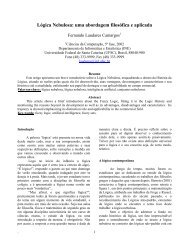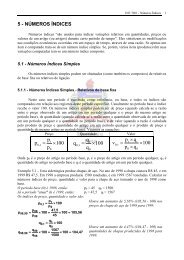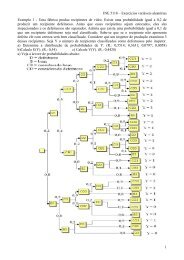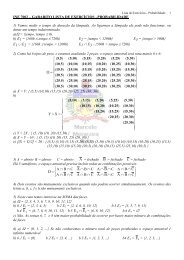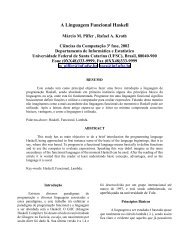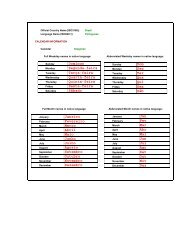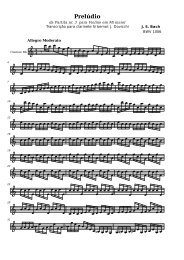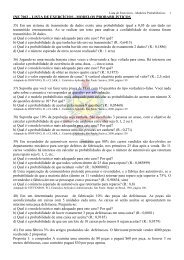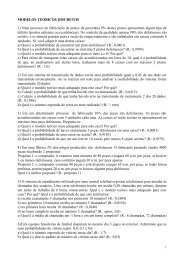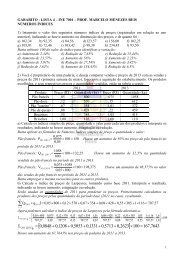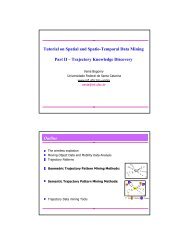Anais do IHC'2001 - Departamento de Informática e Estatística - UFSC
Anais do IHC'2001 - Departamento de Informática e Estatística - UFSC
Anais do IHC'2001 - Departamento de Informática e Estatística - UFSC
You also want an ePaper? Increase the reach of your titles
YUMPU automatically turns print PDFs into web optimized ePapers that Google loves.
<strong>Anais</strong> <strong>do</strong> IHC’2001 - IV Workshop sobre Fatores Humanos em Sistemas Computacionais 235<br />
(and tangible) occurrences of concepts is what characterizes the ability to participate in<br />
discourse.<br />
We will not engage in further consi<strong>de</strong>rations about the parallel between such semiotic<br />
characterization of sign-mastering progression, on the one hand, and learning, on the other.<br />
Our goal is only to discuss HCI <strong>de</strong>sign issues raised by previous research on DM and<br />
learnware. However, an interesting example (among many others) of the connections<br />
between Semiotics and Cognitive Psychology is Piaget’s genetic epistemology [Piaget,<br />
1970]. A parallel between Peirce’s phenomenological categories and Piaget’s levels of<br />
cognitive evolution can be easily drawn. Moreover, Lakoff’s extensive account of<br />
philosophical, psychological and linguistic research that supports his views about the<br />
pervasive role of phenomenologically-rooted metaphors in human discourse [Lakoff &<br />
Johnson, 1980; Lakoff, 1987] provi<strong>de</strong>s additional evi<strong>de</strong>nce of how the linguistic rendition<br />
of abstract concepts is groun<strong>de</strong>d in relations and perceptions that we could characterize as<br />
cases of secondness and firstness in human experience.<br />
Thus, our semiotic account of the findings reported in experiments carried out with Super<br />
Tangrams ©<br />
allows us to propose that:<br />
• DOM is not an appropriate interface style for learnware if the objects being<br />
manipulated are not sufficient to represent the necessary <strong>de</strong>notations involved in<br />
linguistic formulations of the principles to be learned.<br />
In other words, if we expect learners using DOM to formulate principles such as<br />
“when crossing parents with pure contrasting heredity traits, the next generation of<br />
individuals will exhibit the characteristic of only one of the contrasting traits”, we<br />
should provi<strong>de</strong> them with visual signs (static or dynamic) that can stand for such<br />
notions as ‘crossing’, ‘parent’, ‘heredity trait’, ‘pure’, ‘contrasting’, ‘next<br />
generation individuals’, ‘characteristic’, ‘only one’, and ‘exhibit’. Note that the<br />
visual co<strong>de</strong> is ma<strong>de</strong> up of visual representations and manipulations of these.<br />
• The evolution from manipulation experiences to linguistic formulations leads us to<br />
integrate DCM and RDCM into a two-stage single interactive style. This new style<br />
may be more appropriate for learnware if (a) the concepts being manipulated are<br />
sufficient to represent the necessary <strong>de</strong>notations involved in linguistic formulations<br />
of the principles to be learned, and (b) the constructive path leading from<br />
secondness to thirdness of signs used to represent the concepts involved in learning<br />
can be traced with intermediary visual signs that are progressively less in<strong>de</strong>xical<br />
and more symbolic.<br />
If there are no intermediary signs, leading from indices to symbols, in the<br />
representations used by the interface <strong>de</strong>signer, an important step in constructive<br />
learning may be missing. The ST experiments showed that the three levels of<br />
progressive fading in RDCM played an important role in leading children to master<br />
the geometric concepts un<strong>de</strong>rlying translation, rotation and reflection of polygons.<br />
If, for example, in the <strong>do</strong>main of Men<strong>de</strong>lian heredity laws, there is not a<br />
representational scaffolding that will help learners generalize from concrete<br />
crossings to abstract systematic principles, this step will fall outsi<strong>de</strong> the scope of the<br />
specific learnware tools. Learners may eventually reach the generalization stage,<br />
but the progression will not be mo<strong>de</strong>led in the system as a path. It will be a discrete



